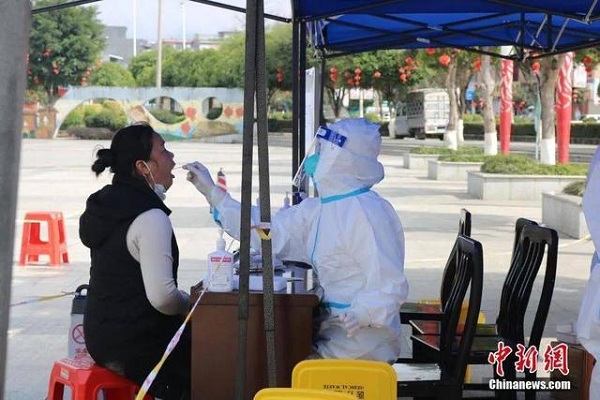Measures are in place to deal with local outbreaks

A medical worker takes a swab sample from a citizen for nucleic acid test at a testing site in Debao county, Baise, Guangxi Zhuang autonomous region, Feb 7, 2022. [Photo/Chinanews.com]
Boosting vaccinations, limiting international movements crucial to control virus spreading
The recent COVID-19 outbreak in the Guangxi Zhuang autonomous region is rapidly developing, health authorities said on Tuesday, as a new study provides evidence on the significance of implementing strict disease control measures, including boosting vaccinations and continuing curbs on population mobility.
He Qinghua, an official with the National Health Commission's Bureau of Disease Prevention and Control, said the overall domestic virus situation remained stable during the seven-day Chinese New Year holiday, which ended on Sunday.
However, new infections in Baise, Guangxi, an area bordering Vietnam, are rising fast, he said at a news briefing, adding that the risk of the virus further spreading is high due to the Spring Festival travel rush.
Local authorities said on Tuesday that the city, with a population of about 3.6 million, had reported 126 cases since Friday.
Residents were urged from Sunday to stay at home and avoid unnecessary travel, and at least three rounds of nucleic acid testing have already been completed in key regions.
"Screening and control of high-risk groups should be stepped up and mass testing should be accelerated to detect potential sources of infection (in Baise) as fast as possible," He said, adding that the State Council's Prevention and Control Mechanism has sent a working group to guide the city's fight against the outbreak.
Meanwhile, infection clusters in Beijing and neighboring Tianjin have been brought under control, said He.
As of Monday, China had fully vaccinated nearly 1.23 billion people, or 87.1 percent of the total population, and about 460 million people had also received booster shots.
With growing vaccination coverage, China has demonstrated its unswerving determination to continue with strict containment measures.
During a meeting setting out key objectives for work in the healthcare sector this year, the top health authority said that China will adhere to the goal of achieving zero infections dynamically, while intensifying its immunization campaign and research on emerging variants.
Chinese researchers led by a team from Peking University said in a new study that despite high vaccination rates, resuming normal population mobility in countries and regions committed to stemming new outbreaks-such as China-would result in a heavy death toll.
The study was published on Friday in China CDC Weekly, an academic platform established by the Chinese Center for Disease Control and Prevention.
Based on a projection model that assumes 95 percent of the global population are vaccinated, researchers predict that lifting international travel restrictions and mobility returning to pre-pandemic levels could lead to over 230 million new infections and 2 million deaths annually in the so-called "COVID-zero regions".
The rates of vaccine efficacy used in the model depend on two previous studies. One was conducted in the United Kingdom and the other in Chile, with the latter involving vaccines made by the Chinese company Sinovac Biotech.
To bring the incidence rates of COVID-19 to the level of influenza or even lower, the study said, the efficacy of COVID-19 vaccines, especially its protection against infection, should be increased markedly.
"The population should continue maintaining non-pharmaceutical interventions and minimize international movement to prevent transmission of COVID-19," it said.
